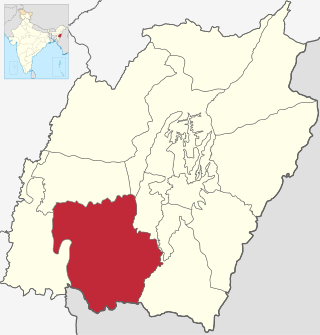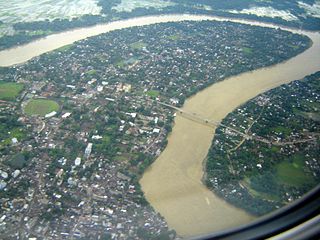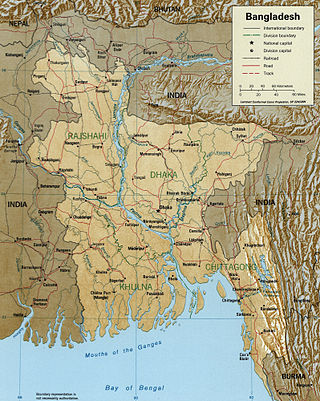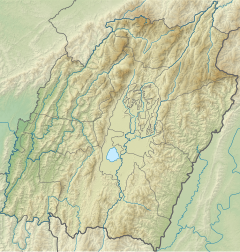Hmar is a Kuki ethnic group living in Northeast Indian state of Manipur, Mizoram, Assam and western Myanmar (Burma) and eastern Bangladesh. They use Meitei language as their second language (L2) in Manipur. They speak Mizo language as their L1 in Mizoram.

Churachandpur District, is one of the 16 districts of the Indian state of Manipur populated mainly by Kuki-Zo people. The name honours former Maharaja Sir Churachand Singh of Manipur. The district headquarters is located in the Churachandpur town, which is also locally known by the name Lamka.
The Paite people are an ethnic group in Northeast India, mainly living in Manipur and Mizoram. The Paites are recognized as a scheduled tribe in these two states. They are part of the Kuki-Zo people, but prefer to use the Zomi identity. "Guite" is a major clan of the Paite people.

The Kuki people are an ethnic group in the Northeastern Indian states of Manipur, Nagaland, Assam, Meghalaya, Tripura and Mizoram, as well as the neighbouring countries of Bangladesh and Myanmar. The Kuki constitute one of several hill tribes within India, Bangladesh, and Myanmar. In Northeast India, they are present in all states except Arunachal Pradesh.

The Barak River flows 900 kilometres (560 mi) through the states of Manipur, Mizoram and Assam in India. It flows into Bangladesh where it bifurcates into the Surma river and the Kushiyara river which converge again to become the Meghna river before forming the Ganges Delta. Of its total length, 524 km (326 mi) is in India, 31 km (19 mi) in Bangladesh. The upper part of its navigable part is in India — 121 km (75 mi) between Lakhipur and Bhanga, declared as National Waterway 6, (NW-6) since the year 2016. It drains a basin of 52,000 km2 (20,000 sq mi), of which 41,723 km2 (16,109 sq mi) lies in India, 1.38% (rounded) of the country. The water and banks host or are visited by a wide variety of flora and fauna.
Tipaimukh Sub-Division is located in south-western hilly region of Manipur bordering the Indian state of Mizoram. It is one of the six tribal development blocks of Churachandpur district in Manipur state. Parbung is the sub-divisional block headquarters. The total geographic area of the sub-division block is 789.48 km², having 55 villages with the total population of 23,995 approx. The total number of voters is 18,848. The total distance from the Parbung to the district headquarters town of Churachandpur is 247 km through the Tipaimukh Road, also known as NH 150.

The Surma-Meghna River System is a river complex in the Indian Subcontinent, one of the three that form the Ganges Delta, the largest on earth. It rises in the Manipur Hills of northeast India as the Barak River and flows west becoming the Surma River and then flows south as the Meghna River, a total of 946 kilometres (588 mi) of which 669 kilometres (416 mi) are within Bangladesh, to the Bay of Bengal.

Zo is a Northern Kuki-Chin-Mizo language originating in western Burma and spoken also in Mizoram and Manipur in northeastern India.
Churachandpur, locally known as Lamka, is the second largest town in the Indian state of Manipur and the district headquarters of the Churachandpur District. The name "Churachandpur" was transferred from the earlier headquarters of the district at Songpi to the present location, and honours Churachand Singh, former maharaja of the Manipur princely state. The local people reject the name as a colonial imposition and use the native name "Lamka".
The Kuki-Chin languages are a branch of 50 or so Sino-Tibetan languages spoken in northeastern India, western Myanmar and southeastern Bangladesh. Speakers of these languages are Mizo in Mizoram, Kuki people in Manipur, and Chin people in Myanmar.
Tipaimukh Dam, officially "Tipaimukh Multipurpose Hydroelectric Dam Project", is a proposed dam on the Barak River at Tipaimukh in Manipur, India. The purpose of the dam is flood control and hydroelectric power generation. The project was approved by the Government of India in 1999 and entrusted to the North Eastern Electric Power Corporation Limited, later switched to NHPC Limited. Due to environmental concerns as well as concerns in Bangladesh over downstream effects, the project remains under discussion and no construction has yet taken place.
The Kuki–Paite Conflict, also called Kuki–Zomi Conflict, was an ethnic conflict during 1997–1998 between tribal communities in Churachandpur district in Manipur, India. The cause of the conflict may be regarded as the desire for leadership within the tribes, pitting one group that subscribed to the Kuki label against another group that subscribed to the Zomi label, the latter being led by the Paites. The conflict started in June 1997 and lasted for over year, during which 352 people died, thousands of homes were destroyed and over 13,000 people were displaced. The Government of India sent in the Indian Army to attempt to stop the violence, but peace was restored in September–October 1998 only with the initiative of the Church.

The Zomi Revolutionary Army is an armed Zomi nationalist insurgent group formed in 1997, following an increase in ethnic tensions between the Kuki people and the Paites tribe in Churachandpur district of Manipur, India. Its parent organisation, the Zomi Revolutionary Organisation, was founded in April 1993.
The Zo people is a term to denote all the speakers of the Kuki-Chin languages who inhabit northeast India, western Myanmar, and southeastern Bangladesh. The Mizo, Chin, and Kuki people are the main ethnic groups.
Ranglong is an ethnic people belonging to the Kuki people. The majority of the Ranglong people live in a small and densely-packed area in the northeastern part of India, mainly in the border areas of Tripura, Assam and Mizoram.

The Zomi Congress for Democracy, formerly Zomi National Congress, is a political party in Myanmar. Originally formed in Manipur, India, most of its current support comes from Chin State, where the party was originally headquartered. The party is most popular in the Tonzang and Tedim Townships, where their headquarters and strongholds are. The party has 15,000 members in Chin State.
Khuga River, also known as the Tuitha River, is a river in Manipur, India. It originates in the Churachandpur district and flows through the district for much of its course. It enters the Imphal Valley near Torbung, and flows east, joining the Manipur River near Ithai. The Khuga River valley in the Churachandpur district is thickly populated, with the Churachandpur town and numerous villages.
Thangjing Hill , is a mountain peak in the Indian state of Manipur. It is in the Churachandpur district, to the west of Moirang. The north-south-running mountain range on which it sits is also called Thangjing range or Thangjing Hills. The range forms part of the western border of the Imphal Valley.
Torbung is a census village split across the Bishnupur district and Churachandpur district in Manipur, India. The Bishnupur part of the village has a population of 2781, and the Churachandpur part a population of 1047 in the 2011 census. Torbung is on the bank of the Torbung river, which flows down from Thangjing hills to join the Khuga River. It is a village of historical as well as current political significance.
Henglep is a village in the Churachandpur district in the Manipur state of India, populated by about a thousand Kuki-Zo people. Henglep is also the headquarters of the Churachandpur North subdivision with a population of more than 30,000 people. Henglep was a key area of operations during the Kuki Rebellion of 1917–1919.










